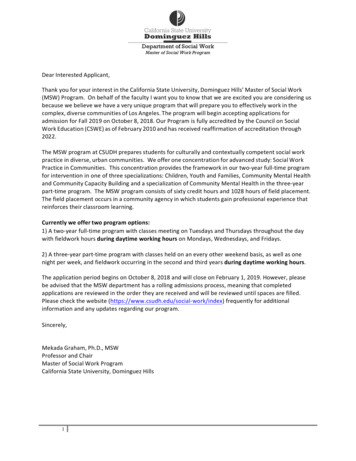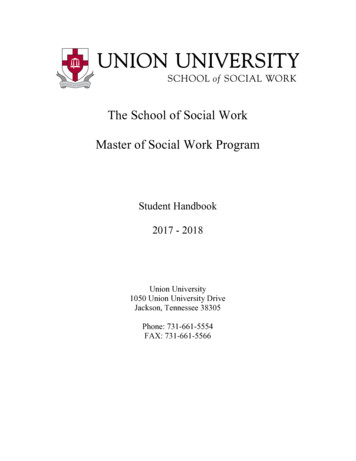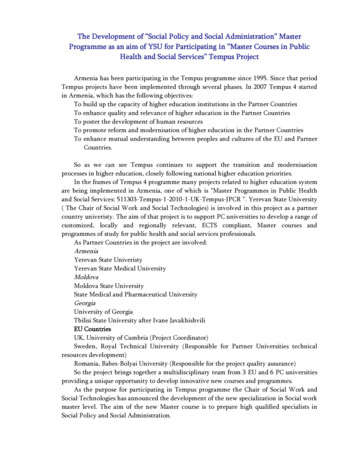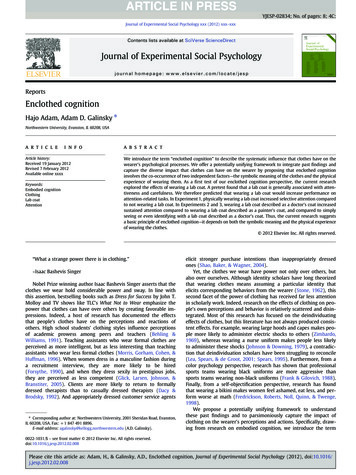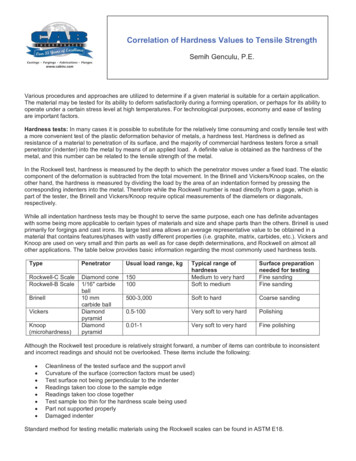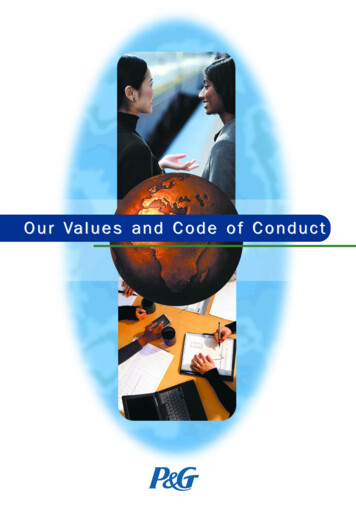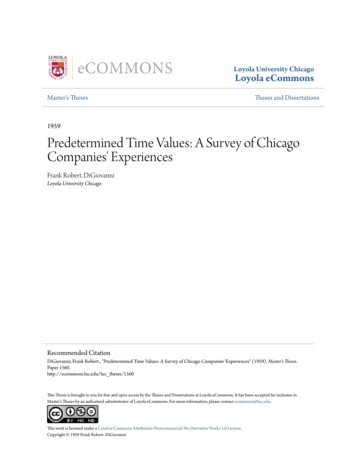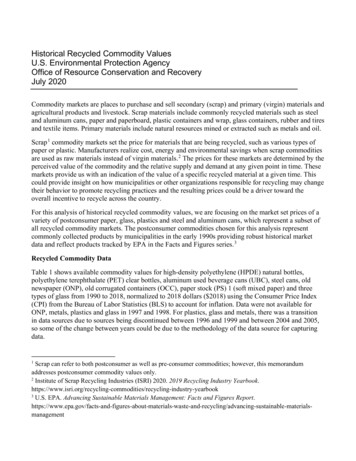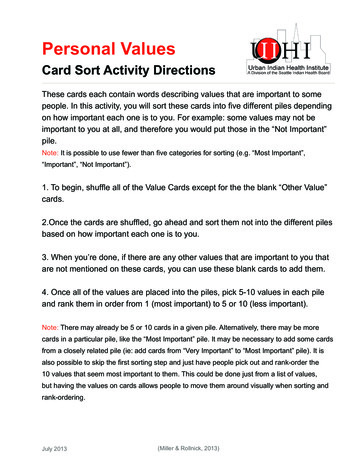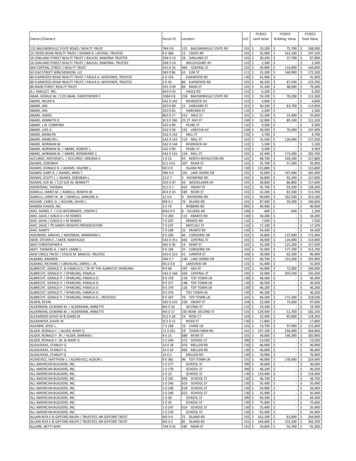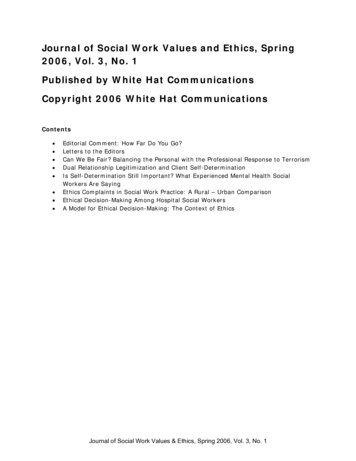
Transcription
Journal of Social Work Values and Ethics, Spring2006, Vol. 3, No. 1Published by White Hat CommunicationsCopyright 2006 White Hat CommunicationsContents Editorial Comment: How Far Do You Go?Letters to the EditorsCan We Be Fair? Balancing the Personal with the Professional Response to TerrorismDual Relationship Legitimization and Client Self-DeterminationIs Self-Determination Still Important? What Experienced Mental Health SocialWorkers Are SayingEthics Complaints in Social Work Practice: A Rural – Urban ComparisonEthical Decision-Making Among Hospital Social WorkersA Model for Ethical Decision-Making: The Context of EthicsJournal of Social Work Values & Ethics, Spring 2006, Vol. 3, No. 1
Editorial Comment: How Far Do You Go?How Far Do You Go?Stephen M. Marson & Jerry FinnCheating in college! Literature on the subject is quite distressing and sadly cheatingappears to be on the increase. We suspect that cheating in social work departments is nodifferent than any other areas of study. We have two particularly terrible examples ofacademic dishonesty.The first had to do with a quiz and the aftermath. A student who was sitting in the back ofthe classroom complained that she could have a higher grade if she cheated as two otherstudents had. The (social work) professor asked the two students to visit his office. Whenthe first one arrived, he naively asked about the possibility of cheating. She immediatelybroke into tears and claimed she didn’t. She was merely handing “whiteout” to her friendwho had asked to borrow it. When the second student came to visit, in the same naïvemanner, the professor asked her about cheating. She was outraged and lost her temper in amanner unprecedented for a student. Although the professor was in the classroom, he sawno cheating and therefore had no first hand evidence to pursue adjudication. However, hehad an intuitive sense that cheating had occurred.After the second student (the one with the temper) graduated, she obtained employment asthe only social worker in a small rural hospital. During a complex review of the medicalcharts, the staff came to the horrendous conclusion that this hospital social worker hadconsistently fabricated a large number of social histories, progress notes, and so forth. Insome cases, she was writing social histories and progress notes on patients she had neverseen. Upon this realization, she was fired and told to leave the hospital premisesimmediately and never return. Although that happened ten years ago, that hospital will notaccept field work students from the BSW program nor will they hire any of its graduates. Inaddition, few human service workers in this rural county are unaware of the story of thefabricated medical records. As a result, the former hospital social worker cannot obtain aprofessional position.The second story is much more complex. Susan pushed to be placed in a field setting thesocial work program had never used in the past. The director of the field workaccommodated her. Early in the semester, she complained that it was a terrible experiencebecause she was not seeing any clients. Through a series of complex arrangements, thestudent was removed from this placement and started with another agency. After shegraduated, pieces of a complex puzzle emerged. A second social work student asked 1 Susanto gain her field placement at the first agency in order to procure mental health records ofthe second student’s husband. The second student wanted to employ these confidentialrecords for an upcoming divorce proceeding. Copies of the records were passed from onestudent to the other. When the deed was completed, Susan was able to switch her fieldplacement.Journal of Social Work Values & Ethics, Spring 2006, Vol. 3, No. 1
Prior to any of this being uncovered, Susan was accepted into an MSW program withadvanced standing status. At the same time, Susan had been requesting to purchase termpapers from current social work majors and graduates. These terms papers were to be usedtoward her MSW degree! After the discovery, the chair of the social work departmentcontacted the MSW program and forwarded a series of certified affidavits regarding themental health records. In addition, the MSW administrators learned of her alleged purchasesof term papers. At least three lawyers were involved and, due to the complexity of the law,nothing could be done. To everyone’s best knowledge, both of these characters arepracticing social work.Major questions constantly should haunt us about both of these situations. Do social workstudents who cheat in the process of learning also act in unethical manners in theirprofessional practice? The first case suggests “yes.” However, little support is found in theliterature. The professor who was involved in both of these examples attempted to conducta national survey of academic misconduct. No social work program would reply or allowtheir students to complete the survey – even though the same survey was employed inresearch for other academic programs. One comment was that “the IRB [InstitutionalResearch Board] would not permit” the acquisition of such information.The big question is this: What responsibilities do social work professors have to identify,prevent, and adjudicate cheating within our respective academic programs. We do not seethis issue as “yes, we should address cheating” or “no, we shouldn’t,” but rather theintensity of our involvement. Or, stated more clearly, how far should professors go toprevent and address cheating?1Probably for the exchange of money.Journal of Social Work Values & Ethics, Spring 2006, Vol. 3, No. 1
Letters to the EditorsDear Editors:First, I would like to tell you how much I like the e-journal and hope that you will continueto have this available to the public. I am a clinical social worker and my specialty isgerontology. Currently, I am also a candidate for a PhD in social work at Simmons Collegein Boston, MA.You asked the question about splitting the journal into practice and academic/researchsections. That idea might be helpful to some readers. However, if a research article isrelevant to social work practice would people not read it if it were placed in the researchsection? I, personally, read everything, even if it is not in my particular area. I find there isa great crossover. Research articles should be "readable," and thus of interest to allpractitioners.Thank you for your contributions to social work knowledge.Sincerely,Elise Beaulieu, MSW, LICSWSteve and Jerry,Congratulations on another successful publication of the Journal. I remember the birth ofthis journal. I praise you for your willingness to make the Journal widely accessible. I foundthe article on dual relationships in rural practice particularly helpful. I have directed it tomy students and rural colleagues in Eastern Kentucky. We have a huge problem gettingpeople to use mental health services in our rural areas. Their concerns usually center onconfidentiality.Doug Burnham, Professor (Retired), University of Eastern KentuckyJournal of Social Work Values & Ethics, Spring 2006, Vol. 3, No. 1
Can We Be Fair? Balancing the Personal with the ProfessionalResponse to TerrorismCan We Be Fair?Balancing the Personal with the Professional Response to TerrorismDenise Ellis, Ph.D., C.S.W., Kean University, Department of Social Work, Union, New JerseyJournal of Social Work Values and Ethics, Volume 3, Number 1 (2006)Copyright 2006, White Hat CommunicationsThis text may be freely shared among individuals, but it may not be republished in anymedium without express written consent from the authors and advance notification of WhiteHat Communications.Key Words: Values and ethics, terrorism, September 11th, disaster, post traumatic stressdisorder (PTSD)AbstractGiven the recent terrorism events in the U.S. and the ongoing threat of additional acts, it isimperative that social workers consider the ethical implications that affect the ability toprovide for clients, students, and ourselves. This paper examines the role of core values ofthe NASW Code of Ethics, personal values, fears, safety concerns, limitations and strengthsas social workers practice in the new era of terrorism.1. IntroductionActs of terrorism have been in the nation’s spotlight since 9/11. Terrorism impacts everyoneeither directly or indirectly. Social workers are human first, and are not immune to therecent and ongoing events and threats of terrorism. They also experience the same fear,anger and personal safety concerns as the general population in response to dramaticimages of violence, mayhem, death and destruction. Consequently, American values andbeliefs based on equality, free speech, freedom to practice religion, and right to privacyhave been called into question. While it is dangerous in other parts of the world, living inthe U.S. has also become potentially dangerous. Neither race, ethnicity, educational oreconomic status, nor religion is a guarantee of safety in the U.S. (Ellis, 2004). As a result,there may be a gap for some social workers’ between their personal and professionalresponses. The highly emotionally charged atmosphere requires that social workers criticallyexamine any bias or prejudice that may exist. Failure to do so would compromisepractitioner effectiveness.The profession of social work is guided by a Code of Ethics that parallels American valuesand provides a moral road map to enhance practice. The National Association of Social Work(NASW) urges an examination of a role for the United States in working in cooperation withother nations, to reduce inequity and wide discrepancies that contribute to social injusticeand resentments that may in turn lead to conditions that spawn terrorism. Furthermore,they attempt to put some of these variables in perspective, and to prepare the professionfor possible future attacks. NASW (2002) refers to a prediction by (Johnson, 2000) whosuggests, "Given its wealth and power, the United States will be a prime recipient in theforeseeable future of all of the more expectable forms of blowback, particularly terroristJournal of Social Work Values & Ethics, Spring 2006, Vol. 3, No. 1
attacks against Americans in and out of the armed forces anywhere on earth, includingwithin the United States" p. 223.This paper examines the challenge for social workers to practice in an era of terrorismevents in the U.S. and the challenge to balance our personal and professional responses.Terrorism is defined in this article as "the unlawful use of force and violence against personsor property to intimidate or coerce a government, the civilian population, or any segmentthereof, in furtherance of political or social objectives" (FBI, 2001). Ethical considerationsthat affect social workers’ ability to provide for us, clients directly and indirectly affected byterrorism, and students are also addressed. A review of research suggests a relationshipbetween values and ethical principles. This paper will highlight the historical effects andcurrent research on the effects of war and terrorism, social work values and ethicalprinciples that guide practice. In addition, the responses of the professions of psychiatry,public health, education and social work are identified. This is followed by a discussion ofthe ethical implications of the core values in the Code of Ethics as they apply to serviceprovision to people directly and indirectly affected by terrorism.2. Historical Effects of War and TerrorismSince the American Revolution the United States has been attacked four times. The attackswere the bombing of Pearl Harbor in 1941, the first bombing of the World Trade Center(WTC) in 1993, the Oklahoma City bombing in 1995 and the second bombing of the WTC in2001. Both bombings of the WTC and the Oklahoma City bombing were carried out byindividuals with no known ties to any government and were labeled as terrorist attacks. Incontrast, the attack on Pearl Harbor was considered an act of war by the U.S. government.An act of war is an attack on one country carried out by a government of another country.Terrorist attacks are acts implemented by individuals who appear to operate outsidegovernment channels, but who may have government ties.During WWI and WWII, the majority of research on the effects of stress was conducted onmilitary personnel, by the U.S. Army and the U.S. Navy, rather than on civilians. A review ofhistorical literature covering the periods of WWI and WWII chronicled the reactions ofAmerican and British soldiers under the stress of combat (Appel & Beebe, 1946). Warneurosis, operational fatigue, combat stress and shell shock were the initial terms usedinterchangeably for a range of symptoms that came to be known as Post Traumatic StressDisorder (PTSD). Of the western nations involved in WWI, the British military were thefurthest behind in understanding trauma. WWI British military authorities attempted tosuppress reports of psychiatric casualties because of the demoralizing effects on the public(Showalter, 1985). Three hundred and six British soldiers exhibiting symptoms of shellshock, including confusion, and walking around dazed and listless, were subsequentlyexecuted for what would now be labeled PTSD. The executed soldiers were accused of beingweak, inadequate and cowardly (UK National Workplace). Additional symptoms included,but were not limited to exhaustion, anxiety, fear, sleeplessness, irritability and aggressivebehavior (Grinker & Speigel, 1945).Research conducted during and immediately following WWII provided additional informationabout the re-entry experiences and the impact of combat related stress for soldiers, theirfamilies, and the communities to which they returned. During this period, psychiatrists,rather than social workers played the major role in the provision of mental health servicesto armed forces personnel and their families, with the primary intervention beingpsychotherapy (Grinker & Spiegel, 1945). Since WWII, social work has increasinglyassumed a central role in the provision of psychotherapy.Journal of Social Work Values & Ethics, Spring 2006, Vol. 3, No. 1
The syndrome of chronic trauma has evolved to include symptoms of anxiety, agitation,constant state of vigilance, intense fear, chronic apprehension of doom, nightmares,irritability and feeling of detachment (Herman, 1992; Straussner & Phillips, 2004).Additionally, those affected by PTSD commonly experience issues around basic trust andquestioning of faith (Herman, 1992). It was not until 1980 that the American PsychiatricAssociation included ‘post traumatic stress disorder’ in its official manual of mental disorders(Herman, 1992; American Psychiatric Association, 1980).Several parallels exist between the response of citizens during the next era, the Cold Warand, the post 9/11 era. First, during the Cold War era, when the threat of nuclearannihilation existed, the U.S. government, then as now, advised citizens to be prepared foran attack. A retired social work educator related her experience during this period."Americans knew there was a threat, something to which we needed to be alert. However,although the government presented the threat as imminent, average Americans went onwith their lives" (Personal communication). Second, public buildings of the time had air raidshelters, equipped with non-perishable food and other supplies, to be used in case of anattack. These shelters were the forerunners of ‘safe rooms’ that today’s Americans wererecently encouraged to prepare in their homes by the Dept. of Homeland Security. Inaddition to traditionally recommended supplies, duct tape and plastic sheeting have beenadded. Third, individuals and groups who were viewed as a threat to national security weretargeted and discriminated against.An explanation of recent targeting is based on the U.S. government conclusion andsubsequent public awareness that Osama bin Laden and all nineteen hijackers whocommandeered planes on 9/11 had the following characteristics: 1) they were Muslimmales; 2) from the Middle East, (most from Saudi Arabia); and 3) were identified asmembers of Al Qaeda. Since 9/11, pictures have routinely been displayed of menacinglooking men in turbans, often brandishing weapons. Those who fit the profile of suspectedterrorists have been officially and selectively denounced, with the accompanying emotionalresponse of moral revulsion (Ahmad, 2001). The difficulty is not knowing with certainty whois and is not engaged in terrorist activities. However, it is a short leap for the public, to viewanyone with any of the above characteristics as suspicious if not guilty of terrorism.3. Recent Research on the Effects of Terrorism in the U.S.There is a paucity of data and information about the ongoing effects of terrorism on peoplein the U.S. prior to 9/11. This is primarily due to the extremely limited number of terroristattacks that have occurred on U.S. soil.World Trade Center Bombing 1993This was the first attack on U.S. soil since the bombing of Pearl Harbor. One account of theexperiences and impact of the World Trade Center bombing in 1993 on children in theimmediate vicinity was discovered in the literature. Some children were stuck in an elevatorin a nearby elementary school during the bombing. They later received crisis counseling.Webb (1994) noted that "school personnel tended to discount the impact of the response onchildren [but] some parents later reported that their children continued to experiencesleep disruptions, and that some were afraid to go on elevators" (p.15).Oklahoma City BombingJournal of Social Work Values & Ethics, Spring 2006, Vol. 3, No. 1
The major attack in terms of loss of life that occurred in the later half of the last centurywas the Oklahoma City bombing in 1995. The Traumatic Stress Studies Program, of the(Department of Psychiatry of the Mount Sinai School of Medicine, 2004) concluded thefollowing after a review of the research about the effects of the event and ongoing traumaon citizens directly involved: Survivors reported increased anxiety, depression, increased use of alcohol, stressand PTSD symptoms a year after the bombing (North, Nixon, Shariat, Mallonee,McMillen, Spitzanagel & Smith, 1999). "Two years after the bombing, 16% of children and adolescents who livedapproximately 100 miles from Oklahoma City reported significant PTSD symptomsrelated to the event" (Pfefferbaum et al, 1999). In the Oklahoma City bombing "adults who sought mental health services hadreactions of being nervous and being upset by how other people acted when thebombing occurred was predictive of PTSD" (Tucker, Dickson, Pfefferbaum, McDonald& Allen, 1997).Moreover, they predicted that the community would function as a critical source of supportand help those directly and indirectly affected to overcome symptoms associated withtrauma. It was their belief that symptoms if present would lessen with time (Department ofPsychiatry of the Mount Sinai School of Medicine, 2004).9/11 AttacksA review of the literature revealed limited results of any mental health studies on civilianswho were at any of the Ground Zero sites. The New York City Department of Health andMental health is conducting a long term study on the health impact of 9/11 on the peoplewho lived and worked in the area of the World Trade Center and emergency responders.Toward this end, they have developed the World Trade Center Health Registry to identifyand track the data. To date, 40,000 have registered (NYC Dept. of Health and MentalHealth).Bocanegra & Brickman (2002) conducted a study on 77 displaced Chinese workers in thevicinity of the World Trade Center complex. The results indicated, "One third of the samplewas classified as at least moderately depressed, and 21% met diagnostic criteria for posttraumatic stress disorder; however, few had utilized mental health services (p. 55).4. Psychiatry, Public Health, Nursing and Education Policy ResponsesPsychiatry, public health pro
Prior to any of this being uncovered, Susan was accepted into an MSW program with advanced standing status. At the same time, Susan had been requesting to purchase term . Denise Ellis, Ph.D., C.S.W., Kean University, Department of Social Work, Union, New Jersey . Journal of
